By Barbara O’Neill. Published on Egyptological, Magazine Edition 8. 18th April 2013
Introduction
The following article developed out of an earlier research project on Heqanakht and the society in which he lived (link here to article?). Heqanakht’s papyri are now owned by The Metropolitan Museum of New York, and although permission to publish images of the papyri arrived too late for their inclusion in the original article, these images now permit further exploration of the individual papyri in greater detail.
The Papyri ~ An Overview
Heqanakht’s ‘letters’ consist of a number of related papyri which have been dated to the early part of the Twelfth Dynasty (2025-1700 BC). The papyri deal with the day-to-day concerns of a well-to-do, land owning farmer who lived near Thebes and who carried out his professional duties as a kA-priest near Memphis. The letters and accounts which make up the papyri were found unopened and, apparently unread, ‘in the condition of their original shipping’ (Goedicke, 1984, p.5). In two instances, the letters still bore their original clay seals, figure 1.
The documents were most probably carried to Upper Egypt by Sihathor, an employee of Heqanakht, who appears to have served in multiple roles including courier and estate worker. Sithathor was also Heqanakht’s ‘household scribe’ (Allen, 2002, p.116). The question as to whether Heqanakht’s courier was waylaid by robbers or whether he mislaid his parcel of papyri through other circumstances remains unanswered. Whatever the circumstances of their loss, the papyri were recovered from a remote part of the Theban necropolis within the burial chamber of a man named Meseh, an individual who may have been related to Ipi, vizier to Amenemhet I (ca. 1976-1947 BC).
In addition to his letters, Heqanakht’s courier may have been carrying a large piece of fine ‘mn’ cloth, woven in the north (Goedicke, 1984, p.51). This cloth is mentioned in Letter I, and in Letter II we learn that it was a valuable commodity worth 24 deben, a considerable sum. The cloth was to be bartered in payment for the rent of agricultural land (Goedicke, p.6). If Sihathor was carrying this cloth, along with other items of value, it is feasible that he was robbed on his way home and that the possibly incriminating bundle of papyri was subsequently discarded by thieves. Herbert E. Winlock, who found the letters during the Metropolitan Museum’s 1921-1922 mission, theorised that the bundle was swept up into the detritus of a nearby tomb which was then sealed following the tomb owners burial. The exact circumstances of the papyri’s find site remains an intriguing conundrum.
Although found as an ‘integrated lot’ bound together and unopened, the papyri were addressed to three different people in three different places. Some of the letters and accounts were addressed to Merisu, Heqanakht’s estate manager at his estate which was located at a place named Nesbesyt. Nesbesyt was probably a sizeable settlement area to the south of Thebes.
Another of the papyri was addressed to an official named Heru-Nefer who lived at Perhaa. Perhaa appears to have been a ‘good sized regional center’ located about a day’s journey north of Nesbesyt (Allen, 2002, p.123).
One of the letters was written on behalf of a woman named Satnebsekhtu who had a flax processing workshop at Khepshyt, a belt of rich agricultural land, close to Perhaa. The exact location of this settlement is unknown, although, significantly later there is a reference to a group of singers and dancers from Khepshyt in the Opet-festival reliefs of Tutankhamun in Luxor Temple (Allen, 2002, p.123; Goedicke, 1984, p.12). Toponymical information on locations within Perhaa suggest it was situated within the Abydene nome
Details in Satnebsekhtu’s letter suggest that she may have been a neighbour of Heqanakht’s at Nesbesyt. Her letter is focused on household concerns and on payments to her estate workers. It was probably as a neighbourly act that Heqanakht’s courier was delivering Satnebsekhtu’s correspondence. An alternative view is that she managed Heqanakht’s flax processing business. A woman with the same name is listed as manager of his weaving workshop. Like so much else, the relationship between Heqanakht and Satnebsekhtu is unclear. Satnebsekhtu appears to have been also temporarily located in the north and absent from her Upper Egyptian home when this letter was written (Goedicke, 1984, p.99).
The supposition that Sihathor was a valuable employee is reinforced by Heqanakht’s request that Merisu ensure that Sihathor should return to his master in the north, once the upcoming harvest was complete. As that season’s inundation was only just underway when the letters were written, it would be quite a while before Sihathor was expected to return north, presumably carrying replies to Heqanakht’s questions and with updated accounts from the Nesbesyt estate and the Perhaa land rental and weaving businesses. Unanswerable questions abound: what were the repercussions when none of the documents reached their destination? How long was it before Heqanakht realised that Sihathor had neither delivered his letters nor (possibly) arrived safely at Nesbesyt? Answers remain as illusive as the individuals concerned.
Another intriguing mystery centres on a woman named Senen. Senen was a maid employed within Heqanakht’s household. She appears to have offended his new wife, a woman named Hetepet-Iutenhab, to such an extent that Heqanakht repeatedly asks his estate manager to dismiss Senen, demanding that she be expelled from the household for unspecified, though evidently serious misdeeds. This situation was so intriguing that the crime author Agatha Christie (also the wife of renowned Near Eastern Archaeologist, Max Mallowan) based her book, ‘Death Comes as the End’ on Heqanakht’s papyri and in particular on the possible scenario involving the unfortunate maid, Senen.
Translations of each of the Heqanakht papyri can be found in Hans Goedicke’s 1984 book, ‘Studies in the Hekanakhte Papers’ and from James Allen’s 2002, ‘The Heqanankht Papyri’. An online translation of the four letters amongst the papyri can be found here: http://www.reshafim.org.il/ad/egypt/texts/heqanakht.htm
NB: Useful information on weights and measures in ancient Egypt can be found here http://en.wikipedia.org/wiki/Ancient_Egyptian_units_of_measurement
Letter I: MMA 22.3.516 – Heqanakht to Merisu
Letter I deals predominantly with economic concerns with detailed instructions to Heqanakht’s estate manager Merisu, regarding land rental and debt collection. Towards the end of this letter, Heqanakht turns to family concerns expressing great concern for Snefru, apparently his favourite (possibly only) son. It appears that Snefru has refused to carry out specific tasks on the estate. Rather than admonish his son, Heqanakht forgives him for his non compliance and instructs Merisu to reinstate Snefru’s allowances and not to be concerned over how hard he works, ensuring that he keeps the boy happy in his father’s absence. It is difficult to see Snefru as anything other than a spoilt child. The other man who receives special greetings is Anubis, who may have been Heqanakht’s younger brother (Allen, 2002, p.114) figure 2
Another key feature of this letter regards the apparent mistreatment of Heqanakht’s new bride, Hetepet-Iutenhab (not to be confused with another woman of the household also named Hetepet; most probably an aunt). It is apparent that Heqanakht’s new bride had recently been introduced into his household in the face of apparent opposition. His new wife has been not been permitted to receive her hairdresser and other servants from outside the household (Allen, 2002, p.185) The main instigator of problems affecting Hetepet-Iutenhab appears to be the housemaid Senen and Heqanakht emphatically demands her instant dismissal. He refers to Merisu as a psSy – literally ‘divider’. The word functions in many different contexts one of which indicates arbitration. Heqanakht appears to order Merisu to act as arbitrator in dealing with household disputes in his absence. In his role as psSy, Merisu is ordered to dismiss Senen and not to be concerned with legal retributions. The fact that there may have been legal repercussions related to the dismissal of a domestic servant is interesting.
Letter II: MMA 22.3.517 – Heqanakht to Merisu
Letter II is concerned with Heqanakht’s family and returns to economic concerns towards the end of the letter. There are instructions to Merisu regarding revision of household salaries in light of an expected poor harvest. Heqanakht’s dramatic statements about hunger and starvation are generally recognised as hyperbole; ‘it is likely that Heqanakht’s words overemphasise the actual situation’ (Goedicke, 1984, p. 121). It is highly unlikely that there was widespread famine at this time (Allen, 2002, p.171).
Nakht, who is probably Heqanakht’s younger brother, is referred to as Nakht ‘son of Heti’. As Heqanakt’s father is never mentioned, it is assumed that he has already died, leaving Heqanakht as heir to his estate and to the role of kA-servant. A woman named Nefret is sent special greetings in this letter. She appears towards the end of Heqanakht’s salary list suggesting a low rank within his household. One poignant possibility is that although Nefret is believed to have been Heqanakht’s daughter from his first wife and possibly as young as seven years old, she is salaried which suggests she was considered old enough to work (Allen, 2002, p.115) figure 3, figure 4.
Letter III: MMA 22.3.518 – Heqanakht to Heru-Nefer
Letter III is addressed to the ‘overseer of land’ at Perhaa, a man named Heru-Nefer. It seems that debt collection was not a private matter between debtor and creditor but required the services of an impartial ‘third party’ (Goedicke, 1984, p.77). Heru-Nefer appears to have acted as witness in the opening and closing of business loans, guaranteeing the proper execution of the transaction. The fact that an official was involved at both ends of what appears to be a loan between neighbours may imply that the property of the debtor served as security against defaulting (Goedicke, 1984, p.77). It would be interesting to know if Heru-Nefer’s authority was through state appointment or if he was nominated within the community. Heru-Nefer is elsewhere referred to in Heqanakht’s letters as a person through whom arable land may be rented. His services were not free and although the size of his fee is not stated, there is a reference to his payment taking ‘the customary form’ (Goedicke, 1984, p.78). It appears that official assistance was necessary in order for Heqanakht to complete his debt collections and to draw up new land leases.
Supporting the official nature of this letter, it was fastened with a lump of clay stamped with Heqanakht’s personal seal, figure 5. There were regulations concerning the use of seals for private business at this time with their use restricted to official matters (Goedicke, 1984, p.5).
There is a significant difference between the language used in the other letters and the more formal language employed in this letter. Allen (2002) suggests that Heqanakht’s own writing is rich with colloquialisms, quirky spellings and a rougher style than the language used here. Heru-Nefer’s status ‘demanded a formal letter written in accordance with the standards of the literary language’ (Allen, 2002, p.186) It is likely that Sihathor was the scribe of this more formal document, and that he probably also scribed Letter IV (Goedicke, 1984, p.98). The calligraphy and phraseology in both letters are similar, indicating that their scribe, had a better command of the syntax required for such formal communications (Allen, 2002, p.186) figure 6.
Letter IV: MMA 22.3.519 – Satnebsekhtu to her mother & Gereg
Letter IV is from Satnebsekhtu and is addressed initially to her mother, who bears the same name. The letter is also addressed to a man named Gereg who Satnebsekhtu refers to as her imy-r pr or overseer of the house. Gereg appears to be the administrator of her estate. The fact that in this letter Satnebsekhtu gives directives concerning the running of her estate while absent from it suggests that she was either divorced or widowed. She refers to Heqanakht and Sihathor in her letter; both men appear to have been known to her and to her mother. That Satnebsekhtu and Heqanakht were neighbours, would be a plausible reason why they shared a courier in communicating with home (Goedicke, 1984, p.99). We can also perhaps, extrapolate the information that neither are closely related; they maintain separate estates and their respective mothers are different. There is no indication that Satnebsekhtu was part of Heqanakht’s household. The letter consists of requests that her mother and Gereg are not neglectful about maintaining the household in her absence. It may reflect something of contemporaneous social tradition that both Heqanakht and Satnebsekhtu single out their mothers for the initial greeting in letters ostensibly addressed to their respective estate managers, figure 7.
Account V: MMA 22.3.520 – Heqanakht to Merisu
Account V is a comprehensive balance sheet addressed to Merisu. Heqanakht’s ‘holdings’ include a range of commodities apart from the barley, emmer and flax which make up the bulk of his accounts. Amongst the range of other commodities listed are coppice areas where Heqanakht grows and stores small amounts of wood, including willow, moringa, sycamore and acacia. Wood was a scarce commodity in Egypt and it is likely this limited stock was for Heqanakht’s personal use and not items for barter (Goedicke, 1984, p.96).
The list of cattle owned by Heqanakht is broken down into separate categories of adult bulls, recently calved cows, heifers and young bulls. Veiled threats to his cattle hands indicate that these men will be held personally responsible in the event that any animal runs away, is stolen or becomes lame. We also learn from Account V that Heqanakht has tenant-farmers living on his land.
The debtors named in this account are not assigned to a particular geographical area and it is assumed they are all in Perhaa, where most if not all of Heqanakht’s land is located. One of the debtors is identified by the title HqA Hwt or ‘Enclosure Ruler’. This was a ‘prestigious’ title in the Old Kingdom but it is uncertain how significant the title was by early Middle Kingdom period (Allen, 2002, p. 118). Perhaps not all of Heqanakht’s debtors were ‘simple’ farmers? Figure 8
Account VI: MMA 22.3.521 – Heqanakht to Merisu
Account VI is an inventory of outstanding debts at Perhaa. This extensive list appears to have been intended as a guideline to Merisu on all monies due to Heqanakht from people he had leased land to, or made loans to. Four different areas of land, owned or managed by Heqanakht are listed in geographical order; all appear to have been located in the Perhaa area. None of the locations can be securely identified; probably all were small hamlets or farmsteads (Goedicke, 1984, p.87). In amongst the brief listings of places and debtors, one wants to know so much more. Who were Nenrenef and his brother who borrowed grain from Heqanakht and it would be interesting to know more about ‘the dog keeper Hay’ who owed Heqanakht 10 measures of barley. Was Hay the keeper of a pack of hunting dogs owned by an elite Theban? “(I)t is certainly surprising to find a ‘herdsman of dogs’ in an insignificant hamlet in Upper Egypt and one might wonder what his professional duties were” (Goedicke, p.87, p.89) figure 9.
Account VII: MMA 22.3.522 – Satnebsekhtu to Gereg
Account VII is a papyrus dealing with the lady Satnebsekhtu’s accounts. Like some of the other documents, this papyrus was rolled up in its original unopened form and like Letter IV it was addressed to Satnebsekhtu’s household at Nesbesyt. Her accounts contain information concerning the distribution of emmer grain to workers on her estate; payment related to the production of linen and to the delivery of yarn at her flax workshop. There was a considerable emphasis on textile production at both Heqanakht’s and Satnebsekhtu’s estates. Her name translates as ‘daughter of the lord of the weavers’ and although this might simply have been her designated name, Satnebsekhtu does appear to have business interests linked to flax processing. It is tempting to theorise that her father had established his own textile business in the Perhaa area, which she has since inherited. Whether the manufacture of linen was common in Upper Egypt at this time is not clear, although it does seem that private estates were not restricted to agricultural production but that manufacturing, in this case of textiles, was also pursued (Goedicke, 1984, p.103, p.123). Satnebsekhtu’s flax is grown in an area named TAw-wr or Great Wind, which was located within Perhaa. Great Wind contained two kinds of fields, qAt or ‘highland’ which was land that drained quickly after inundation and xrw or ‘lowland’ which was wetter and suitable for growing flax and emmer; crops which require a lot of water (Allen, 2002, p.126) figure 10.
Account P: (Papyrus Purches) – Heqanakht to Nefer-Sebau
Account P or Papyrus Purches was found with Heqanakht’s other papyri, folded and unopened and as with the letter to Heru-Nefer this document originally bore Heqanakht’s seal; ‘strands of linen with a stamped lump of clay accompanied the papyrus’ (Allen, 2002, p.14). Shortly after its find, this papyrus was separated from the other letters which made up the original bundle. It was sold privately, purchased by a British couple, Mr and Mrs. George Beeman in 1922 or 1923 and given to its current owner Mrs. W. Kate Purches in 1958. It was only identified as one of Heqanakht’s letters in 1968 by T.G.H. James, then Assistant Keeper of Egyptian Antiquities at the British Museum who published the document separately in ‘An Early Middle Kingdom Account’ (JEA, 1968) having published the other ‘letters’ prior to this in 1962 (‘The Hekanakhte Papers and Other Early Middle Kingdom Documents’). This document is addressed to Heqanakht’s employee, Nefer-Sebau, although unusually, it has no addressee. There are a number of possibilities as to why this might be the case: the papyrus is a palimpsest and there are faded traces of an earlier letter on its recto. Did this document once bear an address, now illegible due to age or due to the conditions in which the papyrus lay for so many years? This is unlikely, as Account P was undoubtedly part of the Heqanakht bundle and although some are fragmented, all are legible. Another possibility is that this particular document was intended to be hand delivered personally to Nefer-Sebau. The strong possibility that Sihathor was literate meant that he was able to read its contents to a man who may not have had these skills. But why was this letter sealed? As noted before, many questions arising from Heqanakht’s papyri, including this one, must go unanswered, at least for now, figure 11.
Conclusion
All of Heqanakht’s papyri are written in Middle Egyptian but with a number of features which reflect Old Egyptian forms not routinely present in more literary Middle Egyptian (Allen, 2002, p.101). The language used appears to reflect a distinct dialect with the use of colloquialisms which may also have been present in Heqanakht’s speech. There is no consensus on whether the ‘dialect’ used in the papyri reflects Memphite or Theban origins for Heqanakht or the scribe he employed. In two of the more ‘formal’ letters, it is clear that this second scribe, probably Sihathor, was familiar with more literary, ‘modern’ forms of the language of this era. Whatever the case, Heqanakht’s letters continue to fascinate, throwing glimmers of light on lives lived thousands of years ago.
Image Credits
Images of the Heqanakht letters, courtesy of Professor James P. Allen on behalf of the Metropolitan Museum of New York. All images copyright of the Metropolitan Museum of Art, New York.
Bibliography
Allen, J.P., 2002, The Heqanakht Papyri, The Metropolitan Museum of Art, New York.
Goedicke, H., 1984, Studies in The Hekanakhte Papers, Halco, USA.
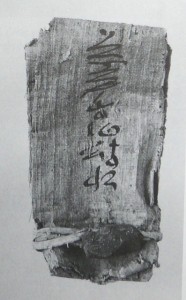
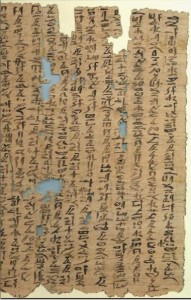

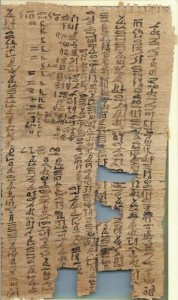
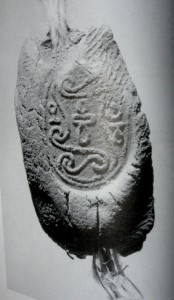
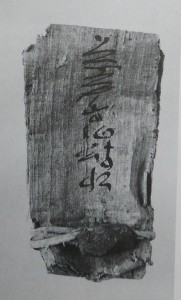
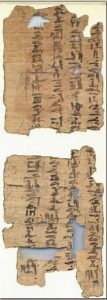
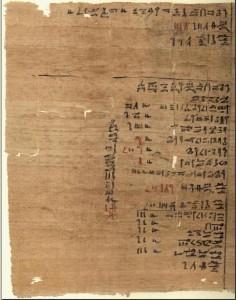
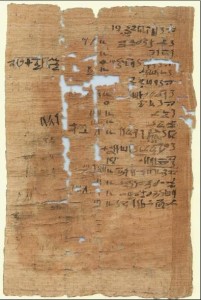
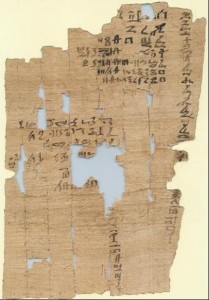
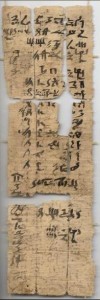
 By
By